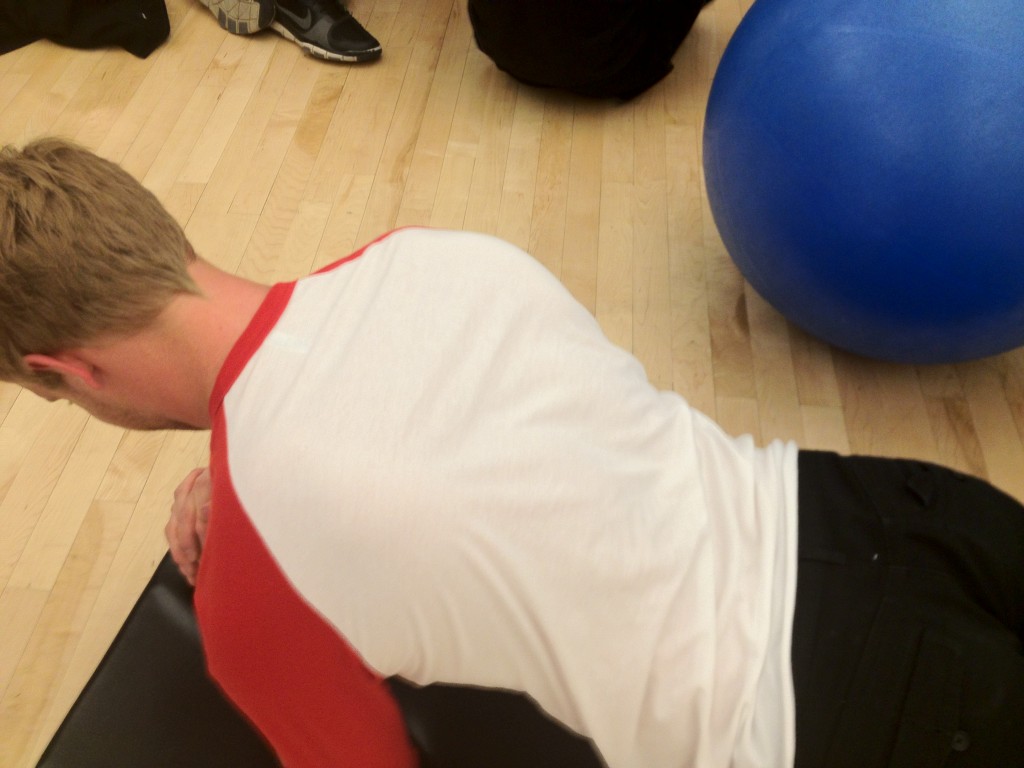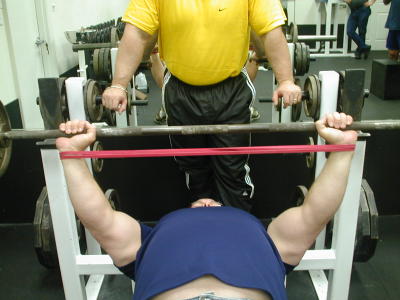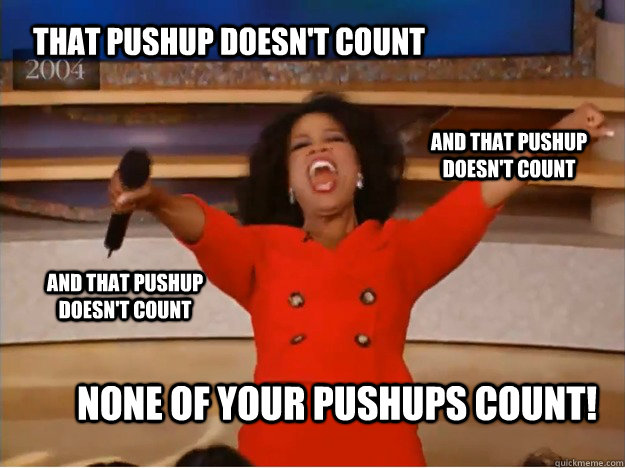Why Pushups Are Awesome
The pushup is to the exercise world what the kicker is to the football world. Yes, they look as basic as a girl named Courtney drinking a pumpkin spice latte while wearing Uggs, a chunky scarf and thick plastic framed glasses, but the kicker is still important to the success of the team. They have to be pretty much automatic from everywhere the coach decides to have them on the field, while guys are trying to push their nose through the back of their spines.
The pushup is very much the same. There’s a lot of people who will say “yeah, pushups are great,” but then when you ask them when the last time they did even one (good) one was, they get a dazed look trying to calculate when Clinton was in charge.
It’s commonly butchered to bang out more reps than possible with reasonable technique, which is why people always like to consider it a foo-foo exercise, especially when you hear of someone who can bang out something like 214 reps in one minutes for a world record, but if we’re not rounding up on each partial 1/8th rep, summed the percent movement for each rep and only came out to a grand total of 2 full reps.
https://www.youtube.com/watch?v=1k4DbN_rNew
Even Gaston gets in on the poor rep contest by doing these shoulder shrug quarter elbow bend pushups to make a guy wearing an Ironman t-shirt at Disneyland look like a jackass, as if he needed any additional assistance to do that.
https://www.youtube.com/watch?v=UGWZY9B_3ZA
Leave it to a guy wearing an IronMan shirt to think he’s got any upper body strength at all.
Now if we’re going to get specific, there’s really only 2 major considerations for a pushup to be “good.” First, touch your chest to the floor (without leading with your face) and then fully extend the elbows at the top, then make sure your spine maintains a constant position throughout the movement.
A pushup is similar to a bench press in movement, but without a bench to press into for support. This means the shoulder blades have to find stabilization against the spine in a different manner because they don’t have an external support structure to rely on. As a result, many people who get into a pushup position almost immediately wind up with their shoulder blades winging off their torso. Not only is this completely reducing the ability of the supportive muscles to provide further stabilization, but it’s pretty much guaranteeing you won’t get any dates and will probably have old ladies kick you in the shin.
In many cases, this scapular winging can be fixed almost immediately with some positional cues. I usually find a lot of benefit from getting people to press up between their shoulders as high as possible, without rounding their upper back or letting their head drop down.
From there, lowering into the pushup shouldn’t involve the person trying to touch their face to the floor ahead of anything else. While that’s just plain funny to watch people rock out Dana Carvey’s Turtle impression, it’s not doing much for your pushup strength except making your neck a little sore after you’re done.
Instead of trying to short change the range of motion by having your head hit the floor 6 inches before your chest, try to think of the first thing contacting the ground being their sternum. The thighs and face shouldn’t come into contact with the floor until you’re done your set and unable to move.
Next, the position of the spine should be maintaining roughly the same neutral position from the top of the movement to the bottom and back up, and every position along the way. In this way, the pushup is essentially a moving plank with a large extension moment placed on the low back. Here’s an example of not controlling your spine during a pushup.
To help fix this, working on maintaining core control is massively important. One often overlooked aspect is breathing. When getting ready to press back up, breathing out hard can have a huge effect on anterior core strength and help resist drifting into extension. This is a common concept discussed in hardstyle planks used by RKC schools of thought.
Using a plank like this can be a good precursor to setting up for a core braced pushup.
Another commonly overlooked and poorly understood corenerstone of the pushup is the glutes. Strong glute control can help to maintain the spinal posture through the movement by essentially locking the hips and lumbar spine together, thus helping to reduce extension of the low back and also making you have a caboose folks would bounce toonies off.
Essentially, when doing the pushups, your glutes should be flexed to a lock out position, where you can’t get any further contraction from them, and then held there for the duration of the exercise. If you do this, it makes holding the spinal position much easier, much more effective, and considerably more challenging than just letting those cakes slap around in the breeze. A tell tale sign of not getting the glutes to fire during a pushup is having your butt stick way out in the air.
Lastly, we need to talk about your grip. In most instances, the hand position on the floor most closely resembles a short stack of pancakes. They’re just kind of flopped there, not really doing much of anything, and just waiting for a slathering of maple syrup. Instead of this, think of the hands as an active system waiting to kick into gear to help your shoulders get more out of the movement.
Open your fingers like you’re getting ready to palm a basketball, dig your fingers into the floor, and then try to turn your hands apart from each other like you’re trying to rip the floor apart. This helps to increase the neural drive through the shoulders, and also increases the activity of the rotator cuff and creating some stability through the scapula as it attaches to the thoracic spine. One way to train this rotation and abduction at the hands is to use a band wrapped around both wrists so that the band tries to pull the hands together and you have to push out against the band to maintain a normal position, much like this picture using the same set up for a bench press.
To give a quick run down of how to smash out some way better pushups:
- Strong shoulders, no winging
- Hit the floor with only your chest, not your face or your thighs
- strong glutes and hard braced abs, no slinky backs on these mugs
- Grip it like you want to rip it.
If you get these main points, the pushup will likely make it’s way further up in your exercise rotation to being a main staple of excellence, and not relegated to something you do in a hotel room when the hotel gym is crap and wants to charge you $20 or $50 to use one of their 2 treadmills and rusty cable system while Cleveland Earl from finance stares way too long to be friendly.
I have a simple motto with most things in fitness: do it so you get the benefit you’re looking for. Finding new ways to do an exercise just for the sake of doing it usually leads to fatigue-related changes in technique, which alters what muscles and movements are involved, and therefore changes what the exercise is doing. If you can’t do an exercise to get the right benefit from it, step it back or change the exercise. Don’t just keep banging away at it.




2 Responses to Why Pushups Are Awesome